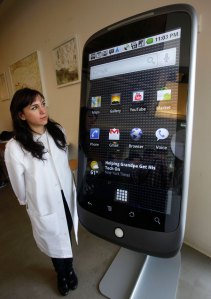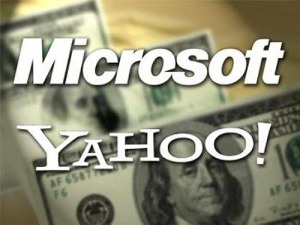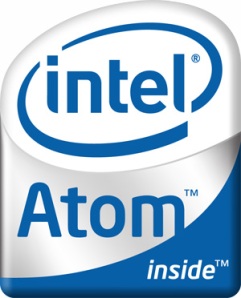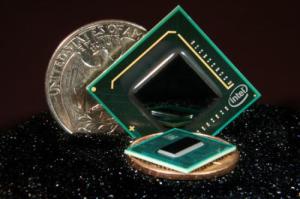Welcome to WordPress.com. This is your first post. Edit or delete it and start blogging!
Hello world!
February 16, 2010Another Milestone Achieved : Google Buzz
February 15, 2010Despite what the leaders of Facebook and Google say, lots of people still like privacy. That was the message many early Buzz users shouted in the days following the launch of Google’s new social networking system. Google seems to have taken quick action to patch some of the privacy flaws people were complaining about, but why were these holes present at launch in the first place?
Google has just announced its new microblogging service designed to compete with established services such as Twitter with Google Buzz.
Google Buzz will be integrated within GMail and will allow for automatic contact and friend lists by email correspondence, public/private sharing and inline inbox integration with real-time updates and multiple source browsing in a single feed with photo browsing.
The service will also support @replies If you @reply someone, it will send a buzz towards an individual’s inbox. The service will also support geolocation by asking the user where their location is with choices automatically generated by triangulation.
Google Buzz also has a “recommended” feature that will show buzzes from people you don’t follow if your friends are sharing or commenting on that person’s buzz. You can remove it or change this in settings.
Google is now speaking about using algorithms to help filter conversations, as well as mobile devices related to Buzz. Google Buzz will also be accessible via mobile in three ways: from Google Mobile, from Buzz.Google.com and from a dedicated app.
Reference: Technews, Technewsworld
How to Connect Port-au-Prince with a Wireless Network
February 5, 2010As you can see from the network diagram above, Inveneo’s long-distance WiFi links connecting NetHope member organizations is starting to be far-reaching. Inveneo engineers Mark Summer and Andris Bjornson have been able to bring high-speed Internet access – critical communication capacity – to eleven relief agency locations with minimal equipment and installation time
Our long-distance WiFi network has made huge improvements in connectivity for NetHope member organizations. Some had no connectivity before. Others had limited connectivity, like a 160 kbit connection that jumped to 1.6 Mbit. That’s like going from 3 dialup connections to a cable or DSL connection.
These leaps in access have immediate impact when 20-100 people are sharing bandwidth at each location. International staff are able to make high-quality Skype video calls when before even voice calls were next to impossible, cutting resupply and rebuilding times by weeks or months.
We want to do more than just build out physical infrastructure; we also want to build the human capacity of local Haitian companies. Eventually, we hope they can deploy these technologies themselves, expanding the benefits of ICT beyond Inveneo’s direct reach.
While we’re fundraising for long-term capacity development, we’re going to start the process of knowledge dissemination with a primer on deploying long-distance WiFI links in Haiti
How to deploy long-distance WiFi links in Haiti
Inveneo has created a methodology for deploying long-distance wireless networks from our many years of work in Africa. So while Port-au-Prince presents it own set of logistical and communication challenges, we were able to install and manage a high-functioning network relatively quickly using these basic steps:
1. WiFi Network Design – make sure your nodes are visible to each other and pointing at the right location
2. Location Capacity Survey – confirming the location can support a network node
3. WiFi Hub Antenna Pointing – aiming the dish for the highest signal strength
4. Installation Trip Preparation – determining what you’ll need before your 30ft up a tower
5. Node Antenna Setup – aiming and connecting the antenna
6. Disseminating Internet Access – networking locally for end-user access
7. Network Management – making sure everyone has equal access to bandwidth
If you’ve read this far, you’ll want to read the full How to Deploy Long-Distance WiFi in Haiti primer and how we and our Certified ICT Partners can bring Internet access to rural and underserved communities in the developing world.
Reference: Wired
The Linux Battle: Ubuntu vs. Fedora
February 4, 2010The userbase of Linux operating systems is growing rapidly. More and more people are venturing away from Microsoft Windows and finding their way to open source operating systems. Just as more people are using them, more and more Linux distributions are available. According to DistroWatch, there are more than 400 Linux distributions available and active, with many versions for each, which in turn gives you thousands of options. With large PC manufacturers starting to offer Linux based operating systems as an option for a new computer, which operating system will come out on top and dominate this industry? Among the open source operating system crowd, there are 2 main contenders: Ubuntu and Fedora.
Ubuntu
First things first, the installation of Ubuntu was very simple and straightforward. No tricky, unfamiliar feats you must overcome. For the first time Linux user, Ubuntu is by far the easiest to start learning and also includes the most basic options which keep things simple. As you learn the operating system and desire additional features and options, they can be added separately which is great for those who are just new to the Linux scene. Most Ubuntu users are probably a little more computer literate than the average user but with a single disc install, anyone could set this operating system up. The set up process detects your hardware very well and things run smoothly. One of the driving forces to a Linux operating system is the unstable and hacker friendly Microsoft Windows. The biggest downside of Ubuntu is that there is no firewall on the system. There are solutions to work around this but this is one feature that should’ve been included. Another disappointment was the limited multimedia resources. You will probably have to look outside Ubuntu to find what you need in the multimedia department.
Fedora
This open source operating system has a strong history and has been a strong contender for awhile. Fedora has been the most consistent with stability issues which have plagued other open source operating systems. The recently added network tools are a great addition to this product and actually include eight tools into one easy to use interface. Your multimedia options are expanded somewhat but Fedora doesn’t provide any support for non open source programs that are really common among other users. The included Helix Player is fairly simple and provides a satisfactory replacement for the average multimedia user. Fedora also lacks some of the bells and whistles and human friendliness of other open source operating systems. The security options exceed those of Ubuntu, which is a strong point for Fedora.
Up to this point, Ubuntu appears to be taking the lead in the open source operating system world with a strong backing from Dell Computers. Both operating systems are fully functional and have surprisingly strong features. If you are new to Linux operating systems, Ubuntu is probably the way to go but Fedora users have no reason to jump ship quite yet.
Microsoft Research: The Vision
January 28, 2010You can imagine the next level of the world we are entering in..
Watch this video:
How Google Could Have Changed the World With Nexus
January 24, 2010If you thought that the world would change with the release of a Google-branded phone this month, be assured that sadly it did not.
At least not yet. It just got one more cool phone.
You can buy the Google Android OS phone, dubbed Nexus One, unlocked directly from Google. But in the United States the only place you can really take it to is the country’s fourth largest carrier, T-Mobile. Or you can buy it through T-Mobile for a hair under $200 and pay about as much per month as a Palm Pre owner and about $20 a month less than an iPhone user.
What would something revolutionary have looked like?
How about a smartphone starter plan, deeply subsidized by ads, that offered a cheap data plan to entice the “I don’t need a smartphone” crowd into joining the revolution? Even better, would have been an order form where you could buy the Google phone and then choose from three or more carriers who are competing to provide you with a data and voice plan — just as you do when you buy a laptop. Instead, there’s just the one option — T-Mobile, which costs basically the same as all the other smart phones.
Google clearly wants the mobile-phone world to look different, it’s just not clear that this phone or its current manufacturing strategy will actually bring about the changes in the telecom world that Google is looking for.
Now, getting on par with Apple (and in some ways past it) is no small feat, especially when Google made this phone in partnership with HTC, a business model that rarely leads to the hardware that the design team really wants. Compare the Nexus One, for instance, to the first Apple phone, which the world has seemingly forgotten — the Motorola ROKR. That phone was limited to having 100 songs on it, couldn’t buy songs over the air and was full of compromises. With the Nexus One, Google managed to make a device that Wired magazine’s Steven Levy called “curvy,” “classy” and “impressive.”
And that’s important, because Google has recognized that mobile computing is a massive part of the net’s future — and thus its own.
With the recent $750 million purchase of mobile-ad provider AdMob and its reported overtures to buy the popular local-business–rating site Yelp, Google is showing it clearly thinks that mobile (and local) is the next place on the net to mine for riches. But what it doesn’t like is all the ways that users could get detoured, from the time they pull the phone out of the pocket until the time their search travels to a Google server.
Remember that the more people use the internet and the faster the internet works, the more Google makes money. Low-cost, uncontrolled devices with low-cost connections equals more people using Google software and seeing Google ads, even if that phone is made by Motorola, Nokia or even Apple.
That’s why it’s pushing hard to break down barriers between the average user and an online Google ad, by finishing the mobile-computing revolution that Apple started, but didn’t finish because of Steve Jobs’ fanatical need to control the iPhone.
Google’s created the mostly open source Android OS, which manufacturers can and are using for free. That’s pushing Microsoft out of the market, and keeping carriers from doing stupid things like forcing a user’s browser home page to divert to its software store in perpetuity, no matter how hard they try to change it. And third-party-app developers can write programs for Android devices without getting permission, a stark contrast to Apple, which must approve every iPhone app and controls the only way to add programs to the device.
Google bet more than $4 billion in an FCC wireless auction in 2008 just to make sure that openness rules would adhere to new spectrum, which led the eventual winner — Verizon — to sue the feds. Google’s won a battle in D.C. to make the wireless companies subject to the same FCC rules that force cable and DSL companies to treat all online content similarly.
In short, Google wants to transform the phone market with its complicated charges, long contracts, bizarre fees and bundling of devices with service plans and make it more like how you buy a television or a computer: Buy the device. Then find the service. That’s even as cable and satellite providers look at the wireless companies and decide those contracts look like a mighty good way to keep customers.
But the question becomes how far does Google have to push, how much capital must it invest, how many devices must it design and regulators must it convince, before it can back out of the mobile hardware business and simply focus on software and advertising?
Here’s the scenario that might get us there: Google convinces HTC that it’s not suicide to create a phone that can be used on any U.S. 3G network (maybe two phones — one for GSM and one for CDMA) and then sells it unlocked. It’s a great phone, and lots of people want it, and there are lots of great apps that run on it.
Users then could then take it to whichever carrier they like, and get a data plan a la carte. The carriers will hate this, perhaps create unfairly high prices and very annoying “device registration fees” — trying to protect the money they make offering phones at an initial discount in exchange for a two-year contract.
But the FCC will have passed a rule forcing carriers to accept any device that doesn’t hurt their network — much as Ma Bell was forced to open its lines after 1968 — and Google, regulators and consumers will break down those barriers. Or the market could simply take care of it, with a desperate Sprint breaking ranks with the other large U.S. telecoms and accepting a Nexus or any other device with no registration fee and a fair price for users.
And that’s when Google will stop making phones, and you’ll know that the Nexus One actually meant something.
Source: Wired
In 2009, Web goes on a diet
December 31, 20092009 was, in many ways, a good year for the Web and the technologies that help us access it. Companies big and small had to re-evaluate what was important: an ethos that channeled into more focused product launches and notable improvements to existing software and services.
That refocus meant tech giants spent the early part of 2009 trimming the fat on services that were too costly to run, or simply underused. Google cut a myriad of its offerings, shelving microblogging service Jaiku, its social network Dodgeball, Google Video, catalog search, “shared stuff,” and its notebook service. Yahoo followed suit, dropping the ax on its Briefcase online storage service, closing off access to its Jumpcut Web video editor, and 360 blogging tool. Yahoo also pulled the plug on Geocities–one of the Web’s early relics. Other notable discontinuations include Microsoft killing off its online encyclopedia Encarta, and HP getting rid of its Upline backup solution.
Services that were not shut down saw improvements. Google’s Gmail finally left beta, and gained a feature that lets users access it offline. The company also launched Google Wave–a somewhat experimental real-time collaboration service. Microsoft’s Windows Live Search was relaunched as a new product called Bing, which was received well both by the press and users. Bing, along with Yahoo and Google, also integrated real-time results from social networks like Facebook and Twitter.
Speaking of Microsoft and Yahoo, Microhoo finally happened–though not as it was originally intended. In late July, Microsoft and Yahoo entered a 10-year search deal that gave Yahoo Microsoft’s search engine technology, while Microsoft got Yahoo’s ad sales force and partners; The result was quite different from 2008’s $44.6 billion unsolicited bid that would have given Microsoft complete control of the company.
2009 also brought new location-based tools, some of which, by some accounts, are a little creepy. Microsoft’s Bing got its own version of local maps, complete with a street-level view. And at the South by Southwest tech and music conference in Austin, Texas, Foursquare debuted. The service lets people show where they are to their friends, and vice versa. The month prior, Google launched a similar service called Latitude that would put a user’s exact location on a map–right down to the city block. Google also expanded its Maps and Earth services, taking street view outside of the U.S., and Google Earth took users to the Earth’s oceans, the moon, and Mars.
Along with search and location, 2009 was a boon year for social networks. Facebook in particular saw huge gains in its number of registered users. It began the year with 150 million users, and is now well past 350 million. That’s no small feat, as recent projections boasted the much-hyped and talked about Twitter somewhere close to 60 million, up from less than 10 million at the beginning of the year. Twitter also gained some celebrity traction, netting an account from Oprah Winfrey as well as Ashton Kutcher. Kutcher went on to become the first Twitter user to hit 1 million followers, beating out news network CNN. He’s since blown past 4 million.
Both Twitter and Facebook also continued to show that they are an integral part in the spread of information. Controversy over Iran’s presidential elections, and the Iranian government censorship that followed made the social networks one of the few places Iranians could go to vent frustrations and pass across news tidbits that would have otherwise gone unseen. Twitter even skipped its scheduled maintenance to stay up–as per a request from the U.S. State Department. Facebook, in turn, rushed to provide support for Farsi so Iranian users could join it.
Twitter was also the first place to go to see photos of U.S. Airways Flight 1549, which had to make an emergency landing in New York’s Hudson River. Nearby ferry riders snapped the first shots of the crash and uploaded them to photo host Twitpic, which ended up crashing because of the sudden, and massive traffic spike.
Besides social networks, voice services and VoIP telephony were big in 2009. E-commerce giant eBay sold off its Skype services to an investor group that now runs it as its own product, with hopes of an IPO in 2010. Google redesigned its GrandCentral service as a product called Google Voice, which was opened up to users after a year and a half of dormancy. Google also snatched up Web-based VoIP service Gizmo5, which could end up being integrated into Google Voice. Other notable telephony launches include 3Jam, which does voice forwarding and transcription, and Ribbit’s mobile service. Both of those companies, along with Google, are trying to get users to manage their calls and voice mails online, functionality that is likely to expand in 2010.
Even with a flashy relaunch, Google Voice had its own share of controversy. This year the service got into hot water with AT&T. It started when Apple pulled all the third-party Google Voice applications from its App Store, along with rejecting Google’s submission of its own Google Voice application. This action caused the FCC to launch an inquiry to see why the apps were removed, as well as why Google’s Voice application was not allowed onto Apple’s store.
It turns out AT&T was not having any part of Google’s blocking phone calls to certain parts of the country that would have cost the company more money to connect users to. In late-October Google bounced back, announcing that it had limited the amount of blocked numbers to fewer than 100. Despite this, 2009 closed out without any Google Voice apps (including Google’s own) making it back onto the App Store.
Finally, 2009 saw a continuation of the browser wars. Mozilla iterated on the third version of its Firefox browser several times, while Microsoft, Apple, and Opera introduced brand new versions of Explorer, Safari and Opera, respectively. Google took the crown though–it managed to jump two version numbers, going from version one to three, with version four currently in developer testing.
Chrome also jumped from being just a browser to a full-fledged operating system. In late November, Google publicly demoed Chrome OS, an instant-on browser-based operating system designed for Netbooks. Users, however won’t be getting their hands on hardware that will run Chrome OS until mid- to late 2010.
Reference: news.cnet.com
China’s Latest Knockoff: Ubuntu in XP Clothing
December 31, 2009What looks like XP but perhaps behaves better? A version of Ubuntu that sports the XP user interface, currently available in Chinese for download from the Web. Whether Microsoft will attempt to assert its intellectual property rights is unknown — and the legal status of the OS is far from clear.
Chinese-language consumers unwilling or unable to pay the cost of a legitimate copy of Microsoft’s (Nasdaq: MSFT) Windows XP now have a new alternative: a clone of the operating system that’s based on Ubuntu.
Dubbed “Ylmf OS,” the software is available from Rain Forest Wind Guangdong Computer Technology as a free download on a dedicated Web site.
The system is based on Ubuntu 9.10 and integrates Wine, according to the page. Also included are OpenOffice 3.1, CompizConfig Effects Settings Manager, Firefox and Pidgin for instant messaging.
Canonical, the company that serves as Ubuntu’s commercial sponsor, could not be reached for comment by this story’s deadline.
‘I Don’t Recommend It’
Uncovered last Saturday by Download Squad, the Ylmf hack is actually not the first instance of Ubuntu being made to look like Windows.
In what may or may not be a coincidence, an Ubuntu fan who goes by the name of Phrank Waldorf received considerable attention on the Linux blogs just a few weeks ago by posting a similar hack, also using Ubuntu 9.10 to emulate Windows XP.
“I don’t use this. I don’t recommend it, either!” Waldorf wrote. “I actually made the script as a programming exercise.”
The response, however, was likely more than Waldorf had expected. Countless enthusiastic comments were left by readers on Waldorf’s page, including at least one asking permission to translate it for a Chinese blog.
‘Far More Interesting Work to be Done’
It’s not entirely clear why Linux fans — many of whom are overtly hostile towards Microsoft — would want to emulate Windows with open source technology.
Indeed, in the open source community, “the general sense is there is far more interesting work to be done differentiating and competing with Windows rather than emulating it,” Jay Lyman, an analyst with the 451 Group, told LinuxInsider.
It’s also not likely such technology holds much promise going forward, Lyman added, “particularly as we see more support for Windows in Linux and other open source software and more support for Linux and other open source in Windows.”
‘A Brazen Effort’
In China, however, it seems at least possible that a Windows clone based on open source software could present a potentially more legitimate alternative to widely available pirated versions. User modification is fully expected in the world of open source software, after all.
On the other hand, can it be acceptable to use open source technology to closely mimic the graphical user interface of a proprietary counterpart? The legality is far from clear.
“Rarely does a brazen effort to pilfer the intellectual property of others appear so blatant as with the Ylmf OS product being circulated in China,” Raymond Van Dyke, a partner with Merchant & Gould, told LinuxInsider.
‘Clear Aim to Interfere’
“The Chinese government should proactively do what they can to squelch this obvious act of hacking and copying a well-known product covered by various patents, copyrights, trademarks and trade secrets, both in the U.S. and in China,” Van Dyke asserted.
While “legitimate reverse engineering of functionalities is acceptable in the U.S., one cannot wholesale copy a protected product, although some functionalities may be worked around,” he explained.
More troubling, however, is “copying the exact design or style of the product, which pirates have absolutely no excuse to copy — apart from their clear aim to interfere with the sales of the legitimate owner or otherwise trade on the owner’s good name,” Van Dyke added.
Better Than the Real Thing?
“If this is an effort to pass off the XP desktop theme as the XP operating system, I don’t think it is going to work,” Joe Casad, editor in chief of Ubuntu User magazine, told LinuxInsider.
“The irony is that this faux Windows system will be safer, more stable and less susceptible to malware than the system it is pretending to be,” Casad noted.
Still, “it never really helps to manipulate the customer,” he added. “We say that every day to Microsoft, and we would certainly say the same thing to people who are trying to make money by imitating Microsoft.”
If the Rain Forest Wind Guangdong company “finds that it gives them a competitive edge to distribute Ubuntu to their customers, they should just admit it,” Casad concluded. “It will be better for both their users and their tech support to have menus that match the underlying system.”
Reference: http://www.technewsworld.com
Intel reveals information about future Atom chips
December 21, 2009Intel’s next range of Atom chipsets seem to be ready to take Nvidia Ion head on. The new lineup will be smaller, faster, will reduce the average power consumption by as much as 20%, and are expected to be available as early as January of 2010. However the best feature of these chips is the integration of a GPU.
As previously reported, Intel’s latest N450 processor and NM10 Express chipset–technology that had been previously referred to as “Pine Trail”–will be used in a new raft of Netbooks that will debut at the Consumer Electronics Show in January. Hewlett-Packard, Acer, Dell, Asus, Toshiba, Lenovo and others are expected to either announce new systems before the show or exhibit new models there.
Intel said there will be more than 80 new Netbook designs–typically priced around $350–on the way, with systems coming available by January 4.
The Pine Trail design squeezes the graphics function, previously on a separate chip, onto the central processing unit, or CPU, a first for Intel. The result–by decreasing the number of chips from three to two–is a reduction in the overall chip package size by 60 percent.
Intel expects robust growth ahead for Netbooks. Nanduri cited numbers from ABI Research that show Netbook annual shipments reaching 100 million units sometime in the next three years. Since introduction, Intel has shipped more than 40 million Atom chips for Netbooks to major PC makers.
Intel is also launching a new Atom processor with two processing cores, the D510, which it is targeted at entry-level desktops and replaces an existing dual-core Atom. Also, a new single-core D410 design is being introduced.
New Atom processors:
• N450: 1.66GHz, 512KB cache, DDR2-667, TDP: 5.5W
• D510: 1.66GHz, 1MB cache, DDR2-800/667, TDP: 13W (2 cores)
• D410: 1.66GHz, 512KB cache, DDR2-800/667, TDP: 10W
(Note: the DDR2 number suffix refers to memory speed; TDP = Thermal Design Power; W = watt.)
By providing a more integrated solution than NVidia’s Ion Platform — which offers Nvidia’s mobile graphics chipsets with the the Intel Atom processor — it is clear Nvidia has some tough competition ahead.
Could Linux Use Some Bells and Whistles?
December 13, 2009Is Linux just too quiet to attract mainstream users who are used to the siren songs of bells and whistles? Or do Linux bells and whistles run on a frequency Windows users can’t hear? “One person’s ‘bells and whistles’ are another person’s ‘this is too different for me’ impediment,” suggested Slashdot blogger Barbara Hudson. For example, “the desktop cube just blows [Windows users] away.”
With the Season of Giving hard upon us once again, it’s a safe bet that many of us are thinking about glitter. Not just glitter, but glitz, sparkle and shine, jingle, bells and whistles.
Such, after all, are the qualities gifts — and the holidays in general — are often expected to have, and manufacturers of everything from ornaments to iPods do their best to make it happen.
What, one might ask, about operating systems? Should they, too, have shiny, splashy, gotta-have features to make them sparkle in users’ eyes?
‘What Are the Killer Features?’
That, indeed, was essentially the question posed by blogger Simon Brew at Linux User & Developer recently, and it’s sparked quite a discussion on the blogs.
“What are the defining features and characteristics of Ubuntu?” Brew began. “Or Mandriva? Or openSUSE? What are the killer features that are born to illuminate point-of-sale material and tedious slideshows the world over?
“What’s… the ‘killer app’ that’s going to get the world excited about Linux?” he asked.
Invisible Appeal?
Brew’s answer: “There aren’t any. There is no single feature to adorn the covers of magazines. There’s no whizzbang gadget to turn the computing world on its head,” he wrote. “Instead, the major appeal of Linux, for me anyway, is that it’s content to be an operating system.”
That, in turn, is a good thing, he concluded: “After all, isn’t the best operating system the one you hardly even notice is there?”
The topic must have struck a chord with residents of the Linux blogosphere, because many of them had a lot to say on the matter.
‘I Feel the Same’
“Nice article, and I would like to say I feel the same,” wrote dhysk in the comments on Linux User & Developer, for example. “Unfortunately the idea of an operating system without bells and whistles as a default [is] one that just doesn’t work as a whole.”
The reason, dhysk added, is that “to most people an OS IS the computer itself.”
On the other hand: Linux “is what you want it to be,” opined cwrinn. “I feel this is the ‘Bells and Whistles’ in a Linux system.”
For Details










